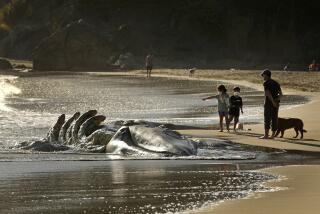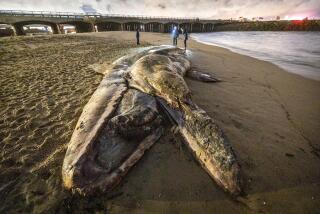The great pursuit
- Share via
ON Jan. 3, 1841, a 21-year-old schoolteacher named Herman Melville set sail aboard the Acushnet, a Yankee whale ship headed for the South Seas. After 15 grueling months, Melville jumped ship in the cannibal-infested Marquesas Islands, figuring that even being eaten would be better than life on a whaler. Still, this failed voyage had a remarkable effect on American culture. Inspired by true stories of vengeful whales -- particularly the sinking of the Essex by an enraged sperm whale and the exploits of an albino whale nicknamed Mocha Dick, legendary for his ferocious attacks on whale ships off Chile -- Melville’s tale of Captain Ahab’s suicidal obsession with killing the white whale Moby-Dick has become a symbol of humankind’s doomed struggle to subdue nature.
On April 27, 1975, a group calling itself the Stop Ahab Committee sailed out of Vancouver on the Phyllis Cormack, a fishing boat chartered by the Greenpeace Foundation in its first whale campaign, to hunt down and halt a Soviet fleet. The Russians were found among a school of sperm whales 40 miles off California near Cape Mendocino.
With cameras rolling, group members maneuvered themselves between a Soviet ship and its target, as a cannon-fired harpoon flew over their heads and exploded in the side of a whale. The international uproar created when this shocking film footage appeared on TV was a critical turning point in the early environmental movement, putting Greenpeace on the map and culminating seven years later in one of the movement’s great success stories, the first international whaling ban. Greenpeace’s rallying cry of “Save the Whales!” helped make environmentalism mainstream and became the symbol of our effort to shift from the habits of exploitation to the habits of conservation.
Whales have always captured the imagination. God himself favored them, according to the King James Bible, not only creating them before all other creatures but giving them their own line in the book of Genesis, Chapter 1, Verse 21: “And God created great whales.” They are truly sea monsters, seemingly half-animal, half-fish, yet mammals like us. They represent nature at its most extreme in size and power and mystery.
At the same time, as Eric Jay Dolin observes in “Leviathan: The History of Whaling in America,” they were also America’s first successful international industry, one that employed hundreds of thousands of workers and created enormous wealth. Whale oil was a key ingredient in the production of soap, textiles leather, paint and lubricants, and above all, it was a source of light. The baleen, a flexible but sturdy keratinous material cut from the whale’s jaw, was used for hoop skirts, corsets, brush bristles and other everyday objects. Yet whaling was not just any business, like timber or mining. Unlike a stand of trees or a vein of gold, whales fought back. These violent battles between the leviathans and the “iron men in wooden boats,” waged in a vast and dangerous ocean, give the subject a rare drama and poignancy.
Dolin, who holds a doctorate in environmental policy and planning from the Massachusetts Institute of Technology and works as a fisheries policy analyst for the National Marine Fisheries Service, begins his story in 1614, with the arrival in New England of the legendary Capt. John Smith in pursuit of gold, copper and whales, dubbed “the Royal Fish” by the English settlers. No gold was discovered, just whales in astonishing abundance. The Pilgrims described watching schools of whales frolicking just offshore, easy to reach but grievously difficult to catch. Instead, the colonists practiced “drift whaling,” harvesting the dead or injured mammals that frequently washed ashore. In one 1700 account, a woman walking the beach between what is now East Hampton and Bridgehampton, Long Island, passed no fewer than 13 stranded whales.
But this easy bounty didn’t last long. Demand for whale oil exploded in the 1730s, when London began mandating the use of street lamps from sundown to sunrise as a crime-fighting measure. In response, enterprising Yankee colonists began “shore whaling,” sailing out with harpoons to hunt within a few miles of the coastline. By 1760, those whales were gone and colonists were forced to go farther out to sea.
Through a combination of opportunity, innovation and obsessive devotion to their craft, the Americans quickly built the most sophisticated and well-capitalized whale industry in the world. They developed techniques, such as moving the furnaces for processing whale oil directly onto their ships, creating one of the first industrial assembly lines and turning their vessels into “floating factories” that allowed for longer, more profitable voyages. They invented spermaceti candles, the brightest, cleanest-burning candles in the world and a tremendously valuable international commodity, further pushing up demand for whales and leading to the creation of the “Spermaceti Trust,” the globe’s first energy cartel.
Nantucket, an improbably small, sandy island off Cape Cod, was now the world’s whaling capital, rivaled only by its land-bound sister, New Bedford, Mass. As one sailor marveled, “every energy, every thought, and every wish of the Nantucketman is engrossed by Sperm Oil and Candles. No man is entitled to respect among them, who has not struck a whale; or at least, killed a porpoise: and it is a necessary for a young man who would be a successful lover, to go on a voyage around Cape Horn, as it was for a young Knight, in the days of chivalry, to go on a tour of adventures, and soil his maiden arms with blood.”
With international trade came a tangle of tariffs, regulations and foreign-policy intrigues that Dolin documents in dizzying detail. Britain’s quest to first control and then disrupt America’s whaling trade helped spark both the War of Independence and the War of 1812. After the latter conflict, U.S. whaling entered its golden age. This is the world so vividly captured by Melville’s “Moby-Dick”: the booming ports; the roughneck sailors from all corners of the Earth; the shipboard grind of boredom, danger and disgusting, bone-tiring labor required to catch a massive sea creature and turn it into a cask of oil.
By this point in “Leviathan,” it is clear that the ultimate battle was not between man and whale but between human ingenuity and natural extinction.
“To the whalemen,” notes Dolin, “whales were swimming profit centers to be taken advantage of, not preserved.” When one whaling ground was fished out, the ambitious Yankees went in search of the next, pushing out into the Atlantic, Pacific and Indian oceans and finally the Arctic. As voyages became longer, averaging four years, captains began relying more on Pacific ports. By the end of the 19th century -- with the discovery of the fierce California gray whales, described by one sailor as a “cross ‘tween a sea-serpent and an alligator,” and the aggressive pursuit of polar whales in the Arctic Ocean -- San Francisco had usurped New Bedford as the No. 1 whaling port in the country.
Like the earlier conflicts with England, the Civil War crippled the whaling industry. Whale ships were commandeered by the U.S. military and attacked by Confederate privateers in an attempt to weaken the Northern economy and divert Union warships. This time, however, when war ended, the industry did not rise again:
Demand for whale oil had been declining for some time as other lighting oils, particularly kerosene, became more plentiful and were improved. At the same time, the price of whale oil was rising, largely due to the growing scarcity of the leviathans, which made cruises riskier and more expensive. Then, in 1859, Edwin L. Drake drilled a well in Titusville, Pa., that struck a deposit of petroleum. Within a year, petroleum wells were producing more oil than whaling at its peak. For a few decades, the whale trade was buoyed by the fashion for tight corsets. But by the early 20th century, corsets were disappearing, and with them the American whaling industry.
There has been a sea change in the last 70 years, as American ingenuity has shifted to conservation -- of both whales and our whaling history. In 1924, the last American whale voyage met an ignoble end, shipwrecked before making it into open water, on the shoals of Cuttyhunk Island off Massachusetts.
A few years later, Mystic Seaport, a museum devoted to the dying culture of seafaring, opened on the Connecticut coast, providing a home for the Charles W. Morgan, the last existing wooden whale ship in the country.
The island of Nantucket has aggressively preserved itself much as it was in its golden age, and this nostalgia has ushered in a new golden age of sky-high real estate values (although any whale-man who came back from the grave would be awfully surprised to see former fish shacks selling for millions of dollars).
“Leviathan” will appeal most to history buffs and ocean lovers. Occasionally, readers may get lost in the details -- it can be a bit like reading “Moby-Dick” without the narrative -- but what details they are! Exotic locations, colorful characters, melodrama and gore aplenty, but also food for thought.
Just last year, at the annual meeting of the International Whaling Commission, Japan nearly succeeded in overturning the 21-year ban on commercial whaling. After all, the exploitation of natural resources is hard-wired into human nature. And human nature is just as tough to subdue or change as any other part of nature. *
More to Read
Sign up for Essential California
The most important California stories and recommendations in your inbox every morning.
You may occasionally receive promotional content from the Los Angeles Times.










